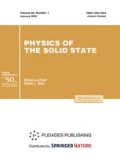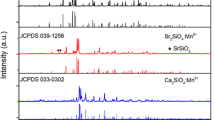Abstract
Multi-component silicate garnet ceramics CaY2MgMAlSi2O12 comprising different cations M = Al, Ga or Sc in octahedral sites doped with Mn4+ ions have been synthesized and studied as novel red-emitting phosphors aiming at warm white pc-LED applications. All synthesized phosphors exhibit Mn4+ luminescence in rather deep red region, the shortest-wavelength spectrum of Mn4+ luminescence (peak wavelength at 668 nm) being obtained for the host with the largest cation M3+ = Sc3+ in the octahedral site. The effect of increasing the energy of the emitting Mn4+2E level with the size of the host cation in octahedral sites is supposed to be the result of decrease of the covalence of the “Mn4+-ligand” bonding with increase of the interionic Mn4+–O2– distance. All studied phosphors demonstrate rather poor thermal stability of Mn4+ photoluminescence with a thermal quenching temperature T1/2 below 200 K, the lowest value being observed for the host with M = Sc. As expected, the decrease of the energy of the O2––Mn4+ charge-transfer state is observed with the increase of the M3+ cation radius, i.e. with the increase of the O2––Mn4+ interionic distance. The thermal quenching temperature of Mn4+ luminescence in the studied phosphors correlates with the energy of the O2––Mn4+ charge transfer state which is supposed to serve as a quenching state for Mn4+ luminescence.










Similar content being viewed by others
REFERENCES
Y.-C. Lin, M. Karlsson, and M. Bettinelli, Top. Curr. Chem. (Z) 374, 21 (2016).
A. G. Paulusz, J. Electrochem. Soc. 120, 942 (1973).
Q. Zhou, L. Dolgov, A. M. Srivastava, L. Zhou, Z. Wang, J. Shi, M. D. Dramićanin, M. G. Brik, and M. Wu, J. Mater. Chem. C 6, 2652 (2018).
K. Petermann and G. Huber, J. Lumin. 31–32, 71 (1984).
T. Jansen, J. Gorobez, M. Kirm, M. G. Brik, S. Vielhauer, M. Oja, N. M. Khaidukov, V. N. Makhov, and T. Jüstel, ECS J. Solid State Sci. Technol. 7, R3086 (2018).
T. Jansen, T. Jüstel, M. Kirm, S. Vielhauer, N. M. Khaidukov, and V. N. Makhov, J. Lumin. 198, 314 (2018).
T. Jansen, T. Jüstel, M. Kirm, J. Kozlova, H. Mändar, S. Vielhauer, N. M. Khaidukov, and V. N. Makhov, Opt. Mater. 84, 600 (2018).
S. Stoll and A. Schweiger, J. Magn. Reson. 178, 42 (2006).
S. I. Omelkov, V. Kiisk, I. Sildos, M. Kirm, V. Nagirnyi, V. A. Pustovarov, L. I. Isaenko, and S. I. Lobanov, Rad. Meas. 56, 49 (2013).
I. Romet, E. Aleksanyan, M. G. Brik, G. Corradi, A. Kotlov, V. Nagirnyi, and K. Polgár, J. Lumin. 177, 9 (2016).
N. M. Khaidukov, M. Kirm, E. Feldbach, H. Mägi, V. Nagirnyi, E. Tõldsepp, S. Vielhauer, T. Jüstel, T. Jansen, and V. N. Makhov, J. Lumin. 191, 51 (2017).
K. A. Müller, Phys. Rev. Lett. 2, 341 (1959).
S. K. Misra, Appl. Magn. Res. 10, 193 (1996).
D. V. Azamat, A. Dejneka, J. Lancok, V. A. Trepakov, L. Jastrabik, and A. G. Badalyan, J. Appl. Phys. 111, 104119 (2012).
R. K. Moore, W. B. White, and T. V. Long, Am. Miner. 56, 54 (1971).
N. M. Khaidukov, I. A. Zhidkova, N. Yu. Kirikova, V. N. Makhov, Q. Zhang, R. Shi, and H. Liang, Dyes Pigm. 148, 189 (2018).
ACKNOWLEDGMENTS
Authors are grateful to P. Ritslaid for performing WDXRF analysis of the studied ceramics.
Funding
This research was performed within the ERA. Net RUS Plus Programme, project NANOLED no. 361. Financial support from Russian Foundation for Basic Research (grant nos. 16-52-76028 ERA_a and 16-53-76027 ERA_a), Estonian Research Council (NANOLED) and BMBF (Germany, grant no. 01DJ16004) is gratefully acknowledged by the Moscow, Tartu and Münster groups. The Tartu group also acknowledges financial support from the ERDF funding in Estonia granted to the Center of Excellence TK141 (project no. 2014–2020.4.01.15-0011) and from the Estonian Research Council grant PUT RG111.
Author information
Authors and Affiliations
Corresponding author
Rights and permissions
About this article
Cite this article
Kirm, M., Oja, M., Kozlova, J. et al. Spectral Properties and Thermal Quenching of Mn4+ Luminescence in Silicate Garnet Hosts CaY2MgMAlSi2O12 (M = Al, Ga, Sc). Phys. Solid State 61, 853–859 (2019). https://doi.org/10.1134/S1063783419050147
Received:
Accepted:
Published:
Issue Date:
DOI: https://doi.org/10.1134/S1063783419050147




